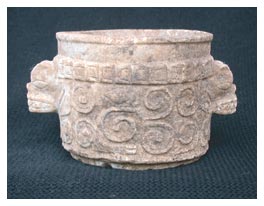
| FAMSI © 2007: E. Christian Wells |
||
Determining the Chronological Significance of an Ulúa-style Marble Vase from Northwest Honduras
Research Year: 2007 Table of Contents
Abstract Through AMS radiocarbon analysis, this FAMSI-funded research project dated five charcoal samples associated with an Ulúa-style marble vase that was recently unearthed during the excavation of a burial at a prehispanic site in the Palmarejo Valley of northwest Honduras. The goal of this effort was to determine the chronological significance of the vase. Four specimens from immediately below and adjacent to the vase yielded a range of dates (cal AD 595 ± 55, 615 ± 45, 625 ± 45, 705 ± 65; all dates represent two-sigma calibration) largely from the beginning of the Late Classic period. One specimen in direct association with the human remains was dated to cal AD 495 ± 85, indicating that the cached vase was added to the mortuary assemblage approximately a century after the initial burial. This research is significant because no complete Ulúa-style marble vase has ever been excavated in situ with modern archaeological techniques. As a result, little is known about when these objects were manufactured and used during the first millennium AD and how these objects functioned in ancient Mesoamerican societies. This research therefore makes an important contribution to our understanding of the use and meaning of Ulúa-style marble vases in southern Mesoamerica. Mediante un análisis de radiocarbono AMS, este proyecto de investigación patrocinado por FAMSI, tuvo la oportunidad de establecer las fechas de cinco muestras de carbón vegetal asociadas con un vaso de mármol estilo Ulúa, recientemente desenterrado durante la excavación de un entierro en un sitio prehispánico en el valle de Palmarejo al noroeste de Honduras. El objetivo de este esfuerzo era el determinar el significado cronológico de este vaso. Cuatro muestras tomadas inmediatamente debajo y adyacente al vaso proveyeron una serie de fechas (cal. d.C. 595 ± 55, 615 ± 45, 625 ± 45, 705 ± 65; todas las fechas representan calibración dos-sigma) que datan principalmente del principio del período Clásico tardío. Un espécimen en directa asociación con los restos humanos proveyó una fecha acreedor de cal. d.C. 495 ± 85, sugiriendo que el vaso fue añadido al ensamblaje funerario aproximadamente un siglo después del entierro inicial. Esta investigación es significativa, ya que nunca antes un vaso de mármol del estilo Ulúa había sido encontrado in situ utilizando técnicas arqueológicas modernas. Como resultado, poco se conoce acerca de cuando estos objetos fueron fabricados y como fueron usados durante el primer milenio d.C. y la función de estos en las sociedades antiguas mesoamericanas. Es por estas razones que esta investigación hace una importante contribución a nuestra compresión del uso y el significado de los vasos de mármol del estilo Ulúa en el sur de Mesoamérica. Click to download the report in PDF format: Determining the Chronological Significance of an Ulúa-style Marble Vase from Northwest Honduras (915 KB) The PDF files require Adobe Acrobat Reader.
Submitted 05/23/2007 by: |
||
|
Text links to all pages at this site are available at the FAMSI INDEX |
||

